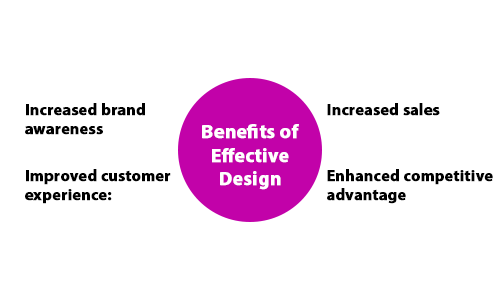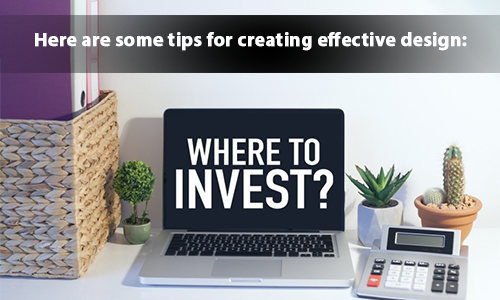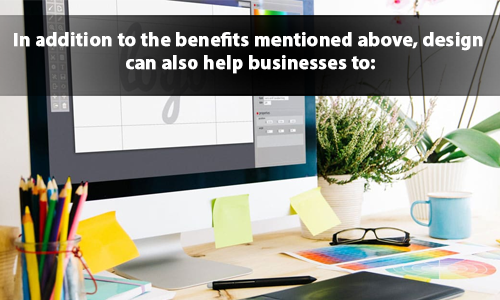How Design Can Help Your Business Grow

In today's competitive marketplace, businesses need to do everything they can to stand out from the competition. One of the best ways to do this is through effective design.
Design is not just about making something look good. It's about creating a product or service that is both visually appealing and user-friendly. When done well, design can make a big difference in the success of a business.
Here are just a few of the benefits of effective design:

- Increased brand awareness: When a product or service is well-designed, it can help to increase brand awareness. This is because people are more likely to remember and remember a product or service that is visually appealing.
- Improved customer experience: Effective design can also improve the customer experience. This is because it can make it easier for customers to use a product or service. When customers have a positive experience, they are more likely to do business with a company again.
- Increased sales: Effective design can also lead to increased sales. This is because it can help to persuade customers to buy a product or service. When customers are attracted to the design of a product or service, they are more likely to buy it.
- Enhanced competitive advantage: Effective design can also give a business a competitive advantage. This is because it can help a business to stand out from the competition. When a business has a unique and visually appealing design, it can attract more customers and make more sales.
If you are looking to improve your business, effective design is a great place to start. By investing in design, you can increase brand awareness, improve the customer experience, increase sales, and enhance your competitive advantage.
Here are some tips for creating effective design:

- Know your target audience: Before you start designing anything, it is important to know your target audience. Who are you designing for? What are their needs and wants? Once you understand your target audience, you can start to create designs that will appeal to them.
- Use high-quality materials: When it comes to design, it is important to use high-quality materials. This will ensure that your designs are durable and will last.
- Keep it simple: When it comes to design, less is often more. Simple designs are more likely to be remembered and appreciated by your target audience.
- Be creative: Don't be afraid to be creative with your designs. Experiment with different colors, fonts, and layouts until you find something that you love.
- Get feedback: Once you have created your designs, get feedback from others. This will help you to identify any areas that need improvement.
By following these tips, you can create effective designs that will help you to improve your business.
In addition to the benefits mentioned above, design can also help businesses to:

- Communicate their brand identity: A well-designed logo, website, or marketing materials can help businesses to communicate their brand identity to customers. This can help to build trust and loyalty with customers.
- Drive traffic to their website: A well-designed website can help businesses to drive traffic to their website. This can lead to increased sales and leads.
- Generate leads: A well-designed lead generation form can help businesses to generate leads. This can help businesses to grow their customer base.
- Improve customer satisfaction: A well-designed customer experience can help businesses to improve customer satisfaction. This can lead to repeat business and positive word-of-mouth.
If you are looking to improve your business, effective design is a great place to start. By investing in design, you can reap the many benefits that design has to offer.
Maximizing Brand Consistency:
Consistency is key in building a strong brand identity. Effective design ensures that all aspects of your brand - from your logo and website to your marketing materials and product packaging - align harmoniously. Consistent branding fosters trust and recognition among consumers, reinforcing your brand's values and message at every touchpoint. This consistency creates a cohesive brand image, making it easier for customers to identify and connect with your business.
Creating Emotional Connections:
Design has the power to evoke emotions and forge meaningful connections with your audience. Thoughtfully crafted visuals can resonate with customers on a deeper level, eliciting feelings of trust, loyalty, and affinity towards your brand. By tapping into the emotional aspect of design, businesses can cultivate lasting relationships with their customers, driving brand advocacy and fostering long-term loyalty.
Optimizing User Experience:
User experience (UX) design plays a pivotal role in ensuring that interactions with your product or service are intuitive, seamless, and enjoyable for users. Effective UX design considers the needs, preferences, and behaviors of your target audience, guiding them effortlessly through their journey and minimizing friction points. A positive user experience not only enhances customer satisfaction but also encourages repeat business and referrals, ultimately contributing to your bottom line.
Staying Relevant in a Digital Landscape:
In today's increasingly digital world, an online presence is indispensable for businesses looking to stay competitive. Effective digital design is paramount for capturing and retaining the attention of online audiences. Whether it's a responsive website, engaging social media graphics, or interactive mobile apps, digital design ensures that your brand remains visible, accessible, and engaging across various digital platforms. By embracing digital design trends and technologies, businesses can stay relevant and adapt to evolving consumer preferences, securing their place in the digital landscape.
Driving Innovation and Differentiation:
Design thinking encourages innovation and differentiation by challenging conventional approaches and exploring new possibilities. By prioritizing creativity and experimentation, businesses can break free from industry norms and carve out a unique identity in the market. Innovative design solutions not only attract attention but also demonstrate a commitment to pushing boundaries and solving customer problems in novel ways. By embracing a culture of design-driven innovation, businesses can differentiate themselves from competitors and position themselves as industry leaders.
Measuring and Iterating for Continuous Improvement:
Effective design is an iterative process that involves constant evaluation and refinement based on user feedback and performance metrics. By leveraging analytics and user testing, businesses can gain valuable insights into the effectiveness of their designs and identify areas for improvement. This data-driven approach allows businesses to adapt to changing market dynamics, refine their strategies, and optimize their designs for better results over time. By prioritizing continuous improvement, businesses can stay agile, responsive, and ahead of the curve in an ever-evolving marketplace.
Conclusion
effective design is not just a cosmetic enhancement; it's a strategic imperative that drives business success in today's competitive landscape. From enhancing brand consistency and fostering emotional connections to optimizing user experience and driving innovation, design plays a multifaceted role in shaping the trajectory of businesses. By investing in effective design practices and prioritizing creativity, empathy, and iteration, businesses can unlock new opportunities, delight customers, and achieve sustainable growth in the long run.
